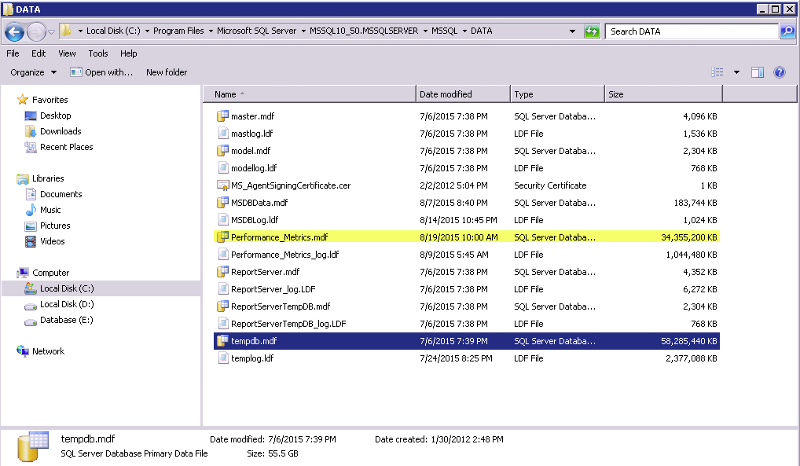bmsande
asked on
SQL 2008 R2 - files using a lot of space
SQL 2008 R2 SP3 installed on Server 2008 R2
Only one database is being hosted from this server and it's stored on D:\
C:\ is filling up and we determined the following two files are the cause:
Performance_Metrics.mdf
tempdb.mdf

We don't have a dba so I need the experts support.
Question 1: I assume performance monitor is enabled somewhere? Can this be disabled and Performance_Metrics.mdf be purged?
Question 2: tempdb.mdf hasn't been written to in weeks. What's up with that, and why is it taking up so much space? Can it be purged?
Thanks!!
Only one database is being hosted from this server and it's stored on D:\
C:\ is filling up and we determined the following two files are the cause:
Performance_Metrics.mdf
tempdb.mdf

We don't have a dba so I need the experts support.
Question 1: I assume performance monitor is enabled somewhere? Can this be disabled and Performance_Metrics.mdf be purged?
Question 2: tempdb.mdf hasn't been written to in weeks. What's up with that, and why is it taking up so much space? Can it be purged?
Thanks!!
ASKER CERTIFIED SOLUTION
membership
This solution is only available to members.
To access this solution, you must be a member of Experts Exchange.
MDF, NDF and LDF are all database files. First rule for SQL Server is not to store database files in C:\ since will fill the drive fast.
I wrote an article on how to move databases. Please give a read in this article and follow the instructions to move the database to another disk.
I wrote an article on how to move databases. Please give a read in this article and follow the instructions to move the database to another disk.
ASKER
Does anyone know how Performance_Metrics.mdf was created? It's not a database listed on our server, and it's constantly being updated (based on modified date). It's growing out of control. Please help us stop/disable whatever may be causing this.
Thanks in advance.
Thanks in advance.
Do you have another SQL Server instance in your server?
If not, then try to attach the database into your SQL Server instance as check if there's any error during the process.
If not, then try to attach the database into your SQL Server instance as check if there's any error during the process.
ASKER
We do not have another SQL instance on this server. This is in prod, I'm afraid someone enabled performance metrics/monitor?? I'll try attaching but it's interesting the modified date keeps refreshing to a recent time.
That database must be attached to another SQL Server. Did you try to attach the file in the current SQL Server instance?
Quite likely someone turned on SQL Performance Monitoring. Check to ensure performance monitoring is disabled if no one is actually looking at SQL performance.
ASKER
Any idea about Performance_Metrics.mdf ?